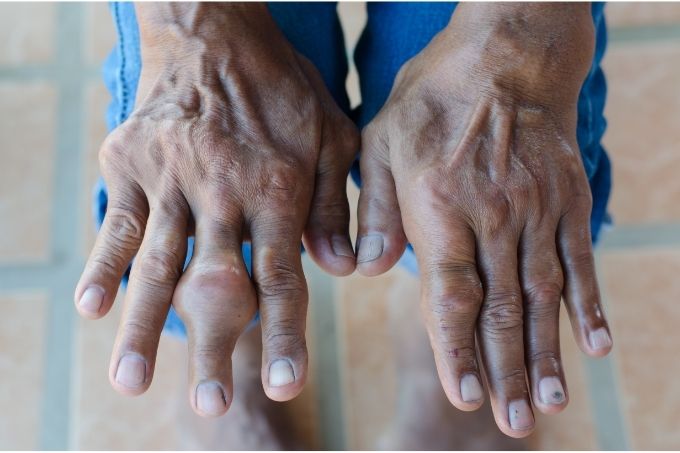
Your fingers play an important role when you grip something and do any manual activity. But, what will happen when you feel pain in your fingers? Your fingers start swelling, and you cannot move them freely. This condition refers to gout in finger. The most commonly affected part is the big toe. However, fingers in your hands may also have a gout attack.
Know more about gout in the finger joint
Gout is a type of inflammatory arthritis that can cause intense pain. It mostly affects the joints in your body. For instance, the end of your limbs has a high risk of gout. Several patients have complained about the gout attack in the metatarsophalangeal joint. But, gout may hit several other sites, including the wrist, elbow, and finger joints.
Swelling and pain in the joint due to a gout attack can last 1 to 2 weeks. In due course, you will again notice the symptoms. Without effective treatment, the symptoms will become highly complicated.
Symptoms of gout in finger
Gout symptoms are similar in finger joints and other body parts. The affected joint may have several symptoms like heat, swelling, intense pain, and discolorations. Check for these symptoms and start the treatment.
Due to the high uric acid level, your tendons and joints will have an accumulation of white and chalky deposits. These deposits are known as tophi, and they look like lumps under your skin. Ultimately, they can cause permanent damages to the joint, and you will have a deformity.
Suggested article: The ULTIMATE Guide to Know Everything about Gout Symptoms
Risk factors of gout in finger
We have already been told that gout in the finger is the result of high uric acid levels. Patients with hyperuricemia may also have gout. Still, who has a higher risk of gout?
- Males
- Obese persons
- Patients taking diuretics
- Those who drink alcohol regularly
- Those who eat purine-rich and fructose-rich foods
Patients taking medications like immunosuppressants, cyclosporine, and blood thinners have a high gout risk. Moreover, the following conditions can cause gout in your fingers.
- High blood pressure
- Diabetes
- Kidney problem
- Insulin resistance
- Congestive heart problem
- Metabolic syndromes

Diagnosing gout in your fingers
A doctor diagnoses finger gout by checking the symptoms. He will also ask you to perform a physical examination with an X-ray of the joints. Uric acid crystal tests are also essential to diagnose gout in your finger. During a gout flare, the joint becomes swollen, hot, and painful.
Some patients mistakenly think of gout symptoms as an inflammatory condition. Thus, it is important to contact a rheumatologist and make the diagnosis more accurate. Arheumatologist specializes in treating arthritic conditions like gout.
Home remedies to treat gout in fingers
Medications are always the best option for treating gout in the fingers. However, patients may also try out some self-management strategies to reduce gout symptoms. A physician will start the treatment with NSAID drugs like ibuprofen. Other anti-inflammatory drugs, including colchicine, are also useful for pain management.
Self-management strategies include an adjustment to lifestyle and diet. They can lower the frequency and severity of gout flares. For instance, you can create a gout-friendly diet chart, do physical workouts, and maintain proper body weight. These are some ways to prevent complications from gout in the finger.
Gout versus rheumatoid arthritis
Patients confuse these two conditions and cannot diagnose them on their own. Both gout and rheumatoid arthritis cause redness, pain in joints, and swelling. Moreover, both of them cause disability and discomfort.
That is why you have to analyze the symptoms closely to differentiate them. The safest option for you is to have an appointment with a physician. He will help you best by diagnosing the signs.
In the case of rheumatoid arthritis, the pain may be severe, moderate, and mild. The joint parts can become stiffer due to this condition. Moreover, these affected parts will become swollen, red, and painful.
Suggested articles:
– Gout and Rheumatoid Arthritis – Similarities and Differences
– What Does Arthritis Feel Like? – Arthritis Symptoms
– Gout and Osteoarthritis – Similarities and Differences
Gout usually starts at the big toe, although your fingers may also have its symptoms.
Interestingly, the researchers could not find the real cause of rheumatoid arthritis. They think that genetic factors and some viruses are responsible for this condition.
On the contrary, purine-rich foods are the commonly known factors causing gout. The conversion of purines into uric acid can cause gout.
Suggested articles:
– Gout in Shoulder – Can You Get Gout in Your Shoulder?
– Gout in Hands – Symptoms, Causes, Treatment
– 4 Stages of Gout and Risk Factors – All You Need to Know
– Gout in Elbow – Can You Get Gout in Your Elbow?
The Gout Eraser™: The all-natural guide for permanent gout removal
The Gout Eraser™ is a short, to the point guide on how to reverse gout symptoms without ever leaving your home. The guide goes into extensive detail on exactly what you need to do to safely, effectively and permanently get rid of gout, and you are GUARANTEED to see dramatic improvements in days if not hours.
To learn more about The Gout Eraser™ system, check out the following free video presentation: The Gout Eraser™





